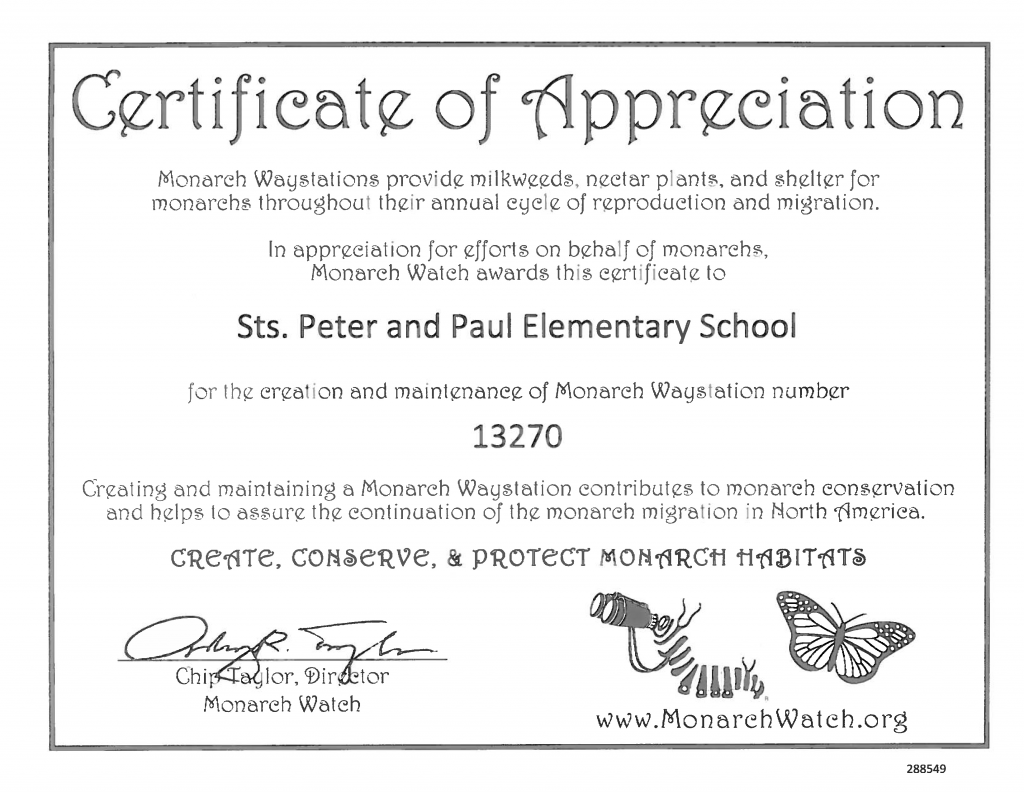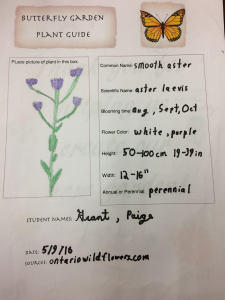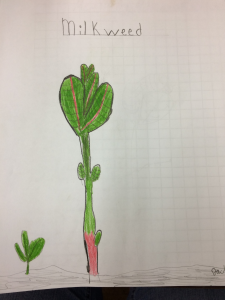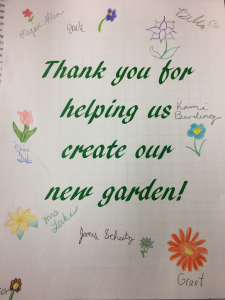This post was contributed by Connie Lake and Deb Moffit, NCEA Monarch Grant Program Teacher Leaders.

We had an exciting month of growth, not just with the plants, but with the expansion of the garden! We continued to have Citizen Scientist Tuesday to learn about new and exciting topics.
Each month we try to incorporate a STREAM unit. This month……
S– Hypothesizing about ‘Why do we have so many volunteer milkweed and how are they spreading?’ We talked about the transfer of seeds by wind, animals, birds, runners- and then decided if we dug down and looked at the roots we may find an answer. We were amazed to see they were connected underground by their roots! (We planted 15 milkweed plants last spring and counted over 50 plants this spring!!!)
T– After the research, we were able to blog about our day. (ourmustardseed.edublogs.org)
R– We know and discuss often how God’s hand is ever-present in our world, more specifically in our beautiful garden.
E– It was time to design the new garden! How do we decide the placement of the plants?? We actually used tape and made a smaller version of our garden in the classroom on the floor. It helped us each see the importance and understand the reason that the placement of the plants is important in the garden.
A-Each student took colored pencils out to their quadrant of the garden and chose a milkweed to sketch and color. (It was awesome listening to them really “see” the colors of the plant! God again!)
M– We learned about equilateral triangles. We learned that all the angles in the measurement of a triangle equal 180° and each angle had to be equal. Now we could make our 18” triangle for use in plant placement.
*Along with all of this we learned how to document as a field reporter. Each quadrant group chose a milkweed plant to monitor. They placed a marker flag with their quadrant’s number on it. From April 19-May 9 the groups measured their milkweed in millimeters and recorded their findings. Then on May 9th we talked about how to make a graph that would show the growth difference over time. We decided a line graph would be the best. Each student then had to review in their minds about how to make a correct graph, using intervals, labeling axes, title, connecting dots with straight lines. They turned out great!
*This month we also had a bee keeper come to our room to discuss the importance and the ins and outs of beekeeping. We were able to see an empty hive, the container bees are shipped in, a smoker, the protective clothing worn, and we heard how after a lot of research, you can be a beekeeper and help preserve the honeybee.
*It was quite an exciting day to have the shipment of 200+ plants arrive. Another learning experience….the plants were tired of traveling and needed to be handled with TLC. We synergized, got them unpacked and helped them feel at home with a nice drink of water!
Our pre-planting days had us marking popsicle sticks with the name of a plant (using a code and color) and then all like sticks were bundled with rubber bands. Once we had that done, we looked at a graph of the potential height of each plant and then decided where each type of plant should be placed in the garden. Then using the 18” triangles, each quadrant could lay out the triangle template and place the plant (stick) where the plant would be placed. Planting day……we assigned each to their quadrant with a ‘runner’. As the student pulled the stick from the marked spot, it was handed to the runner, who went to the ‘plant station’, handed the stick to Miss Deb and was given the correct plant. Once the runner returned, the plant’s hole had been dug, 1 cup of water poured in and the plant had a new home. This went smoothly and all plants were in the ground by noon!!! We took a break at lunch and had a wiener roast! Then back to work wetting layers of newspaper to place on the ground in preparation for the mulch. While this was being done, others were digging a small trench around the garden to detour weeds from entering! Our final moments of the day included getting a gift of a cement statue of St. Francis!!!! A perfect ending to a perfect day!
Learn more about Sts. Peter & Paul Catholic School’s Monarch butterfly activities and more on Facebook and the Our Mustard Seed blog.
Sts. Peter & Paul School in Nauvoo, Illinois, is a two-time recipient of the NCEA Monarch Rescue Grant. Grantee schools will share monthly updates on their efforts in researching, planning, building, and maintaining the very best monarch-friendly butterfly gardens possible. They will monitor the success or failure of the garden, learning from problems they encounter to plan improvements in subsequent years. Most important, the developing learning modules will incorporate Catholic social teaching on stewardship of the resources God has provided us.
Follow the Monarch Butterfly conversation using #NCEAMonarch, search NCEA Talk using keyword Monarch Butterfly Rescue and view the Monarch Inspiration Gallery on Pinterest.


